
My Morse Keys
Nick Kennedy, WA5BDU
At some point I decided that I have (or once had), a number of interesting keys and paddles, so I might as well put them in a web page gallery. I'm not a collector, or at least I'm trying not to be, so I don't still own all of these keys. I'll admit I still have the majority of them though.
The Brown Brothers Paddle

This is my old, beat-up and battle scarred Brown Brothers paddle. Around 1974 I took on one of my first homebrew projects--the Accu-Keyer from the ARRL Handbook. That was a great keyer ... anyway, back then I asked a friend what kind of paddle is good and he informed me that the cognoscenti were using Brown Brothers--which I'd never heard of. But I took his word and ordered one. Now it's a classic. So I missed out on the 240Z but I did get a Brown Brothers paddle.
The Kent Paddle

Here's a great paddle that's still in production. It's a Kent, made in England. Now, I'm too cheap to buy such a nice paddle when I've already got the Brown Brothers, but this one has a story too. The Little Rock Hamfest puts on a CW copying contest as part of the festivities. And somehow, I managed to win it the year they had this great prize. I've found I actually favor this paddle for mobile CW of all things. It stays put on the seat due to its weight.
The Bencher Paddle
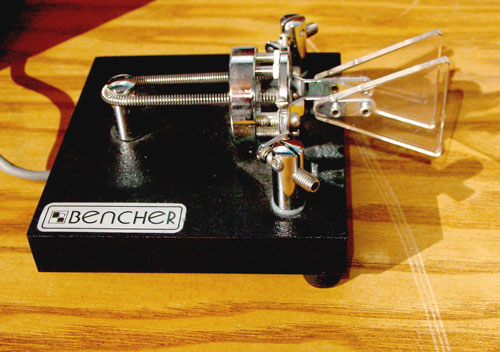
This design has been around a while and is found in many hamshacks. It doesn't get a lot of rave reviews, probably just because it's so common. But the Bencher has nice, original and rather intricate design. It's somewhat fragile but otherwise is a nice key with a good feel. This particular key came integrated into an MFJ model 422B electronic keyer. The electronics slides right off the base, giving the view of just the paddle as seen here.
You know, I've always kinda thought that this key has a long history as the 'FYO' paddle, but wasn't sure. Well, I recently found it in a New Amateur Product column in CQ magazine, October 1962. It was done by W8FYO. I think he also designed keyer electronics to go with it.
My Japanese Bug
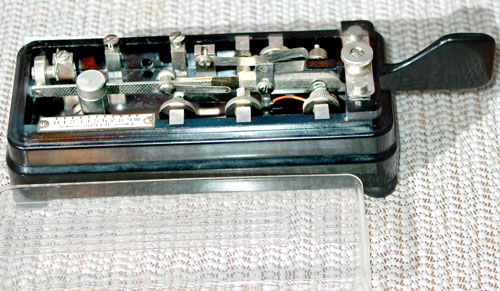
My first bug was one of these--it probably came from Burstein-Applebee around 1964. It was a great key and I really developed my skills in the few short years that I used it. I finally knocked it off a table and broke the bakelite handle off. Then thirty or so years later I found myself in QSO with a guy who collected bugs. I had a nice Vibroplex but it had no sentimental value for me. Then I mentioned the "old jap bug" of my youth to him. Turns out he had one and we traded. This one still has the clear "butter dish" dust cover, seen in the foreground. Maybe it's because I started with one, but I think this bug compares favorably with the much more expensively built Vibroplex. I found out a few years ago the this bug is actually a "High Mound" product. A weird name if I ever heard one. I'll stick with the old tag, updated to the more respectful "Japanese Bug".
By the way, that fabric stuff the bug is sitting on is a trade secret among CW operators. It's a kind of shelf paper found at Wal-Mart and similar places. It has a rubbery feel and a very high coefficient of friction, to keep your bug or paddle from moving around on the desk.
The Vibroplex Bug
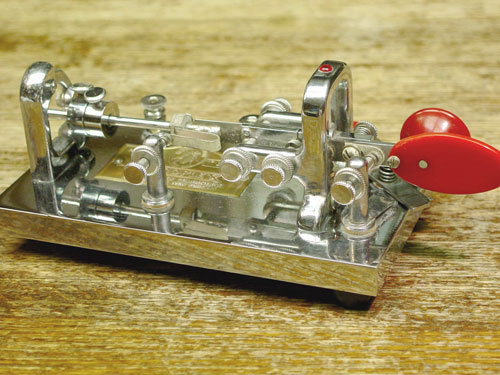
I really wasn't shopping for a bug, but a local ham had this one for sale and it was just too pretty to resist. Doesn't every ham need a Vibroplex? I thought so at the time, but have since sold it and made the Japanese bug my one and only. The Vibroplex is a great mechanical device just to look at, even if you're not a Morse person. But man, these things were fast. Even with the weights full to the left the thing has got to be doing 30 WPM. I always remember my bug sending in my mind's ear as clean and evenly spaced. And I can still send with a bug, but it's not as pretty as I remembered. I might get nostalgic and make a bug QSO now and then--but thank goodness we've got keyers now. Update - I don't have this one any more, but it's such a pretty photo I'm keeping it on the site.
Begali Pearl
I never thought I'd want or actually get one of these rather expensive paddles. It's just a pair of switches, after all. But I used a friend's high-end paddle (not a Begali) at Field Day and thought it really did make sending easier. Next, Christmas approached and I'm the ham who has everything. Pretty much, anyway. So the Begali went on the list. It's nice and heavy and has a great feel.
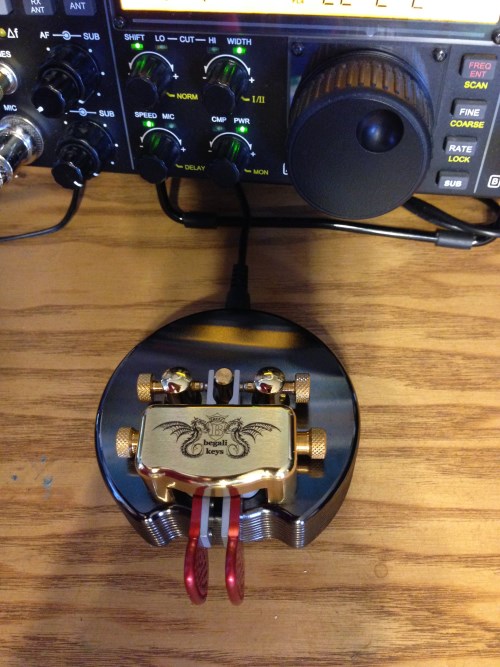
Palm Mini Paddle
I won this nice little paddle in a drawing at a QRP convention. It's plain and functional to look at, but suits me pretty well since I like to do outdoor ham events combined with a little hiking. I have a KX3 with the paddle mounted onto the transceiver, but I think this one is functionally a bit better so I will use it with the KX3 at times. It's easy to send accurately with it and it's quite small. Also, the assembly holding the paddles slides into the housing for safe transporting.

Straight Key - Old Radio Shack Piece
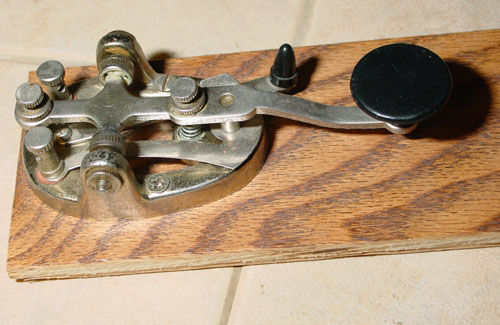
At least I think it's from Radio Shack. this one has been with me longer than any of my other keys--maybe 30 years or so. I don't have my original Novice hand key, unfortunately. It was really nice--even insulated the movable piece from the circuit, prevented that attention getting jolt you got from the transmitter's cathode voltage. But this is a nice, solid key. I mounted it on a piece of hardwood floor planking to make it hold still. Some time back I was wondering if I have to many keys and should I maybe sell this one at the hamfest. As I played around with it, I came to realize that it has a great feel, maybe even better than the J-38. So I'll hang onto it a little longer.
Straight Key - The J-38
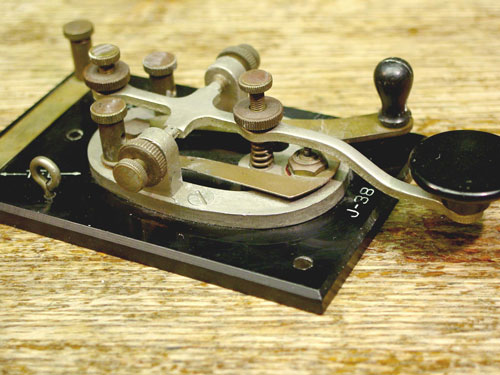
Isn't this a beauty? You'd think that a ham my age would have been through a shoebox full of 'em, but that's not the case. I've heard plenty of tales of WW-II vintage J-38s in army surplus stores at $1 or $2 apiece. But I didn't get my first until I picked up this one at the Fort Tuthill Hamfest in Flagstaff, AZ in 1999. It was $35 and I was glad to get it. But as much as I like a good hand key, pumping one is murder on my arm. Still, I'll always plug it in to one of my vintage transmitters on ARRL's Straight Key Night (New Year's Eve) and make a few QSOs with it.
AZ ScQRPions Mini-Paddle
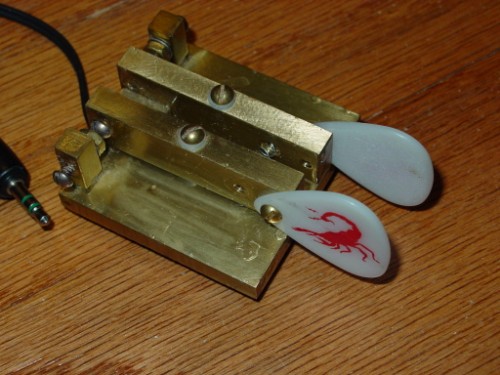
This little paddle is about two inches square--perfect for hams who like to take their little radios on hiking trips. It was sold as a kit by the Arizona QRP club. It's solidly made of heavy sections of brass and although not as sophisticated as some larger paddles in terms of adjustments, I find it easy to use. I keep mine in a Pelican case along with my Altoids case ATS-3 transceiver and some other miniaturized accessories. Note the guitar pick finger pieces having the emblem of the AZ ScQRPions group.
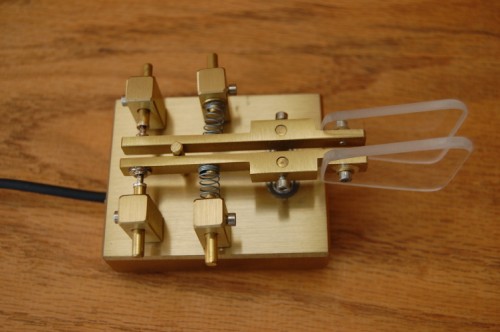
Vibroplex Deluxe Lightning Bug
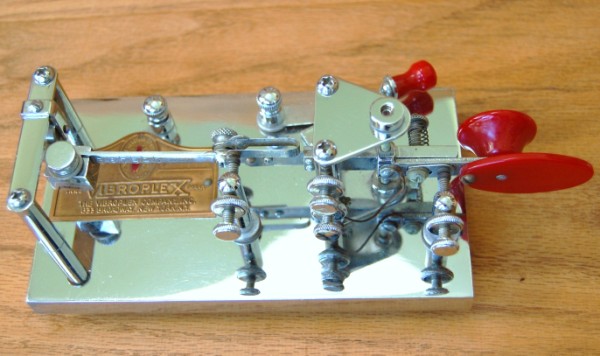
This is a Vibroplex Deluxe Lightning Bug in excellent condition that I found at a hamfest in 2010 and couldn't resist. By its serial number (209,999), I learned that it was probably made in 1959. That bright chrome is super nice.
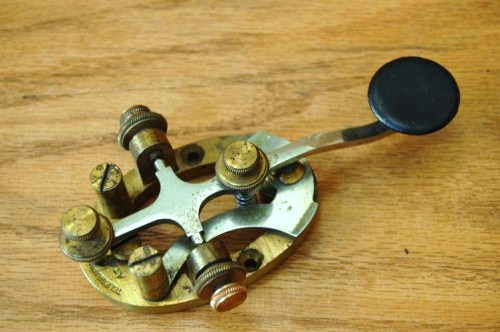
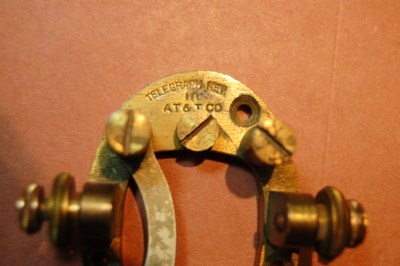
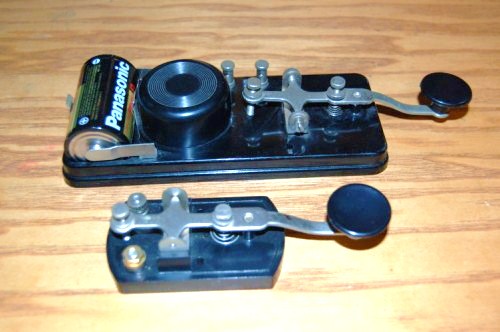
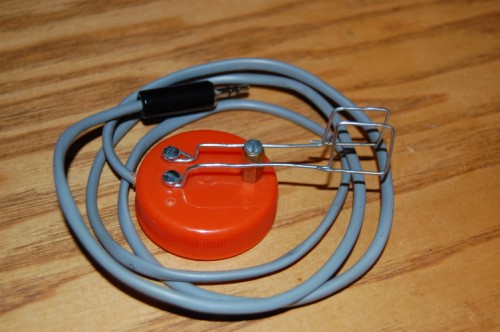
Is this a joke? Well, not really. Sometimes there's a need for a light and simple paddle. One such time might be for radio hiking / field events, to keep weight down. Another is the Adventure Radio Society's monthly ARS Sprint contest in which the total weight of the station, paddle included, is part of the score. (The lower, the better.) That's why I built this one, which was a complimentary kit / gift handed out at one of the QRP conventions by Doug Hendricks of NORCAL and Hendricks Kits. The base is the plastic cap from a bottle of orange drink and the paddles are formed from paper clips. Yes, I can send fairly well with this thing. Just goes to show you ... precision, beautifully machined paddles for $600 and up are made and sold, and no doubt they're worth it to their owners, but a minimal paddle can do the job in a pinch.
Ham-to-English Translation
A paddle is used with an electronic keyer. The keyer makes automatic dots and dashes. The paddle acts like two switches. Push it one way closes the dot switch and you get a string of dots; push it the opposite way and you get dashes.
A Bug is a semi-automatic key that made sending a lot easier and faster before the days of electronic keyers. A long straight shaft connected to the handle end of the key via a piece of spring steel. It vibrated like a pendulum when the handle was banged over to the 'dot' side. Weights regulated the speed. Each time the vibrating rod went full travel, it touched an electrical contact and produced a Morse dot. When the handle was moved in the opposite direction another contact closed and manual dashes were produced. Hence "semi-automatic".
A straight key, AKA hand key, is the old fashioned kind of key that railroad telegraphers used. Plenty of hams still use them on the air. They are usually associated with slower speed Morse operators, but many fine operators just prefer the old hand key.